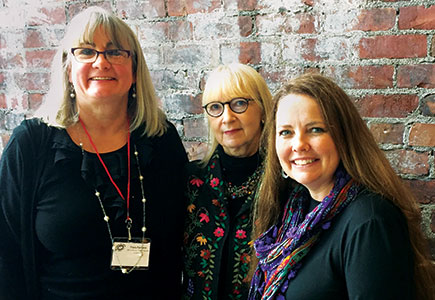Left: Nancy with the co-presidents of the WAEA, Tracy Fortune and Melanie Arbz, at the conference. Right: Nancy on the cover of the WAEA magazine, Splatter, in anticipation of her keynote at their state conference.
I find hope, though, in my belief that the arts can provide a meaningful (and perhaps the best) catalyst to engage individuals and communities to take positive action around social issues. For this purpose, SchoolArts features a monthly art-based, nonprofit social justice project in a column called Focus In. Three of the most familiar may be the Memory Project, Pinwheels for Peace, and the Interdependence Hexagon Project, but we offer many more over the course of each volume year. The interconnectedness and availability of the Internet has enabled social justice projects such as these to grow into global arts-based efforts.
According to studies presented in “Arts Education Matters: We Know, We Measured It,” first published in Education Week in 2014, “exposure to the arts affects the values of young people, making them more tolerant and empathetic.” Having your students participate in arts- based social justice programs is one approach to developing empathy: the ability to become aware of, understand, and share the feelings and emotions of others. Empathy is a key component of emotional intelligence (EI), popularized by psychologist and science journalist Daniel Goleman in his 1995 book, Emotional Intelligence.
Almost all of the social justice projects SchoolArts features involve art-making and art-sharing opportunities for multiple grade levels. Some sites have free educational materials you can download. Others may give you ideas to develop similar projects on a smaller scale. You can learn more about multiple projects at Embracing Art for Social Change. We invite you to explore these projects to foster empathy and meaningful engagement in your students while bringing attention to positive social justice issues. The engaging nature and visual language of the arts places art teachers in an especially unique position to foster empathy in their students.
Many thanks go to Marilyn Stewart, wearer of many art education hats, for her participation as co-editor for this issue. We couldn’t have done it without her!
Email Nancy at NWalkup@DavisArt.com
View this article in the digital edition.



.png)